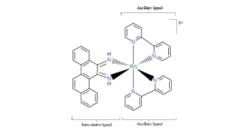Biology:DNA-binding metallo-intercalators
DNA-binding metallo-intercalators are positively charged, planar, polycyclic, aromatic compounds that unwind the DNA double helix and insert themselves between DNA base pairs.[1] Metallo-intercalators insert themselves between two intact base pairs without expelling or replacing the original nitrogenous bases; the hydrogen bonds between the nitrogenous bases at the site of intercalation remain unbroken.[1][2][3] In addition to π-stacking between the aromatic regions of the intercalator and the nitrogenous bases of DNA, intercalation is stabilized by van der Waals, hydrophobic, electrostatic, and entropic interactions.[2] This ability to bind to specific DNA base pairs allows for potential therapeutic applications of metallo-intercalators.
Synthesis of metallo-intercalators
In the case of ruthenium intercalators, the general synthesis consists of preparing intercalative ligands followed by their coupling to a ruthenium metal complex coordinated by specific ancillary ligands.[6][7] Examples of prior ruthenium complexes used as precursors for metallo-intercalators include cis-[Ru(bpy)2Cl2] and cis-[Ru(phen)2Cl2]∙2H2O, which can be synthesized into [Ru(bpy)2(maip)]2+, [Ru(bpy)2(paip)]2+, [Ru(bpy)2(bfipH)](ClO4)2, and Ru(phen)2(bfipH)](ClO4)2.[4][5]
Mechanism of DNA-intercalation

Metallo-intercalators π-stack with unbroken DNA base pairs after entering via a groove, typically the major, (in contrast to metallo-insertors, which replace expelled base pairs after entering double stranded DNA via the minor groove).[9][10] Intercalation of a metallo-intercalator creates less strain in the DNA duplex than insertion; metallo-insertors induce an untwist of the double helix and an opening of the phosphate backbone while metallo-intercalators marginally increase the rise and width of the major groove.[1][9] Intercalation of metal compounds between DNA base pairs effectively stabilizes the double helix, increasing the melting temperature of the DNA duplex.[8] Binding of metallo-intercalators to DNA is reversible and depends on the properties of the intercalating molecule. Metallo-intercalators with different metal centers, oxidation states, coordination geometries, and overall sizes will exhibit varying “depths of insertion”.[3] For example, square planar complexes penetrate deeper into the DNA base pairs than octahedral or tetrahedral complexes do.[3] Also, positive charges on the metallo-intercalator strengthen DNA-binding because of electrostatic attraction to the negatively charged sugar-phosphate backbone.[6]
Therapeutic applications
Metallo-intercalators have a variety of potential therapeutic applications as a result of their structural diversity and universal photooxidative properties. One possible therapeutic application of metallo-intercalators is to combat cancerous tumor cells within the body by targeting specific mismatched DNA base pairs; the ability to modify the ligands bound to the metal center allows for a high degree of specificity in the binding interactions between the metallo-intercalator and the DNA sequence.[11][12][13] For example, the ligand 5,6-chrysenequinone diimine (chrysi) and its analogues are designed to be too wide to fit inside the normal span of the base pairs of B-DNA, causing it to bind instead to the wider portions of the helix at destabilized sites of mismatched bases.[11][12] After intercalation, the sample can be photoactivated by absorbing energy during irradiation with short wavelength light.[1] This activation causes the metallo-intercalator's photooxidative properties to induce a cleavage of the sugar phosphate backbone at the site of mismatch through a radical mechanism.[1][11][12] Even in the absence of irradiation, the interactions between the metallo-intercalator and DNA can substantially decrease the proliferation of cells containing DNA with mismatched base pairs.[13]
References
- ↑ 1.0 1.1 1.2 1.3 1.4 Zeglis, Brian M.; Pierre, Valerie C.; Barton, Jacqueline K. (2007). "Metallo-intercalators and Metallo-insertors". Chemical Communications 44 (44): 4565–79. doi:10.1039/b710949k. PMID 17989802. PMC 2790054. http://authors.library.caltech.edu/9287/1/ZEGcc07.pdf.
- ↑ 2.0 2.1 Gill, Martin R., and Jim A. Thomas. "Ruthenium(ii) Polypyridyl Complexes and DNA-from Structural Probes to Cellular Imaging and Therapeutics - (RSC Publishing)." Chem Soc Rev, n.d. Web. 26 Jan. 2015. <http://pubs.rsc.org/en/Content/ArticlePDF/2012/CS/c2cs15299a>.
- ↑ 3.0 3.1 3.2 Pages, Benjamin J., Dale L. Ang, Elise P. Wright, and Janice R. Aldrich-Wright. "Metal Complex Interactions with DNA." Royal Society of Chemistry, n.d. Web. 26 Jan. 2015. <http://pubs.rsc.org/en/content/articlehtml/2014/dt/c4dt02700k>.
- ↑ 4.0 4.1 Vargiu, Attilio V., and Alessandra Magistrato. "Detecting DNA Mismatches with Metallo-Insertors: A Molecular Simulation Study." Inorganic Chemistry. Inorganic Chemistry, n.d. Web. 26 Jan. 2015. <http://pubs.acs.org/doi/pdfplus/10.1021/ic201659v>.
- ↑ 5.0 5.1 Raman, Natarajan; Rajakumar, Ramasubbu (2014). "Bis-amide Transition Metal Complexes: Isomerism and DNA Interaction Study". Spectrochimica Acta Part A: Molecular and Biomolecular Spectroscopy 120: 428–436. doi:10.1016/j.saa.2013.10.037. PMID 24211801.
- ↑ 6.0 6.1 Liu, Yun-Jun; Liang, Zhen-Hua; Li, Zheng-Zheng; Yao, Jun-Hua; Huang, Hong-Liang (2011). "Ruthenium(II) Polypyridyl Complexes: Synthesis and Studies of DNA Binding, Photocleavage, Cytotoxicity, Apoptosis, Cellular Uptake, and Antioxidant Activity". DNA and Cell Biology 30 (2): 829–38. doi:10.1016/j.ejmech.2009.10.043. PMID 19932529.
- ↑ Du, Ke-Jie, Jin-Quan Wang, Jun-Feng Kou, Guan-Ying Li, Li-Li Wang, Hui Chao, and Liang-
- ↑ 8.0 8.1 Kielkopf, C. L., K. E. Erkkila, B. P. Hudson, J. K. Barton, and D. C. Rees. "INTERCALATION AND MAJOR GROOVE RECOGNITION IN THE 1.2 A RESOLUTION CRYSTAL STRUCTURE OF RH[ME2TRIEN]PHI BOUND TO 5'-G(5IU)TGCAAC-3'" RCSB Protein Data Bank. N.p., n.d. Web. 26 Jan. 2015. <http://www.rcsb.org/pdb/explore/explore.do?structureId=454D>.
- ↑ 9.0 9.1 Lauria, Antonino, Riccardo Bonsignore, and Alessio Terenzi. "Nickel(ii), Copper(ii) and Zinc(ii) Metallo-intercalators: Structural Details of the DNA-binding by a Combined Experimental and Computational Investigation - (RSC Publishing)." Royal Society of Chemistry, n.d. Web. 26 Jan. 2015. <http://pubs.rsc.org/EN/content/articlehtml/2014/dt/c3dt53066c>.
- ↑ Alessandro Biancardi, Azzurra Burgalassi, Alessio Terenzi, Angelo Spinello, Giampaolo Barone, Tarita Biver, and Benedetta Mennucci. |title="A Theoretical and Experimental Investigation of the Spectroscopic Properties of a DNA‐Intercalator Salphen‐Type ZnII Complex" |journal=Chemistry–A European Journal, |date=2015 |volume=20 |issue=24 |pages=7439-7447. |doi=10.1002/chem.201304876
- ↑ 11.0 11.1 11.2 11.3 Pierre, VC; Kaiser, JT; Barton, JK (2007). "Insights into finding a mismatch through the structure of a mispaired DNA bound by a rhodium intercalator". Proc. Natl. Acad. Sci. U.S.A. 104 (2): 429–34. doi:10.1073/pnas.0610170104. PMID 17194756. Bibcode: 2007PNAS..104..429P.
- ↑ 12.0 12.1 12.2 12.3 Junicke, H.; Hart, J. R.; Kisko, J.; Glebov, O.; Kirsch, I. R.; Barton, J. K. (2003). "Bioinorganic Chemistry Special Feature: A Rhodium(III) Complex for High-affinity DNA Base-pair Mismatch Recognition". Proceedings of the National Academy of Sciences 100 (7): 3737–42. doi:10.1073/pnas.0537194100. PMID 12610209. Bibcode: 2003PNAS..100.3737J.
- ↑ 13.0 13.1 Hart, J. R.; Glebov, O.; Ernst, R. J.; Kirsch, I. R.; Barton, J. K. (2006). "DNA Mismatch-specific Targeting and Hypersensitivity of Mismatch-repair-deficient Cells to Bulky Rhodium(III) Intercalators". Proceedings of the National Academy of Sciences 103 (42): 15359–5363. doi:10.1073/pnas.0607576103. PMID 17030786. Bibcode: 2006PNAS..10315359H.
 |



